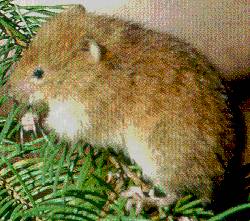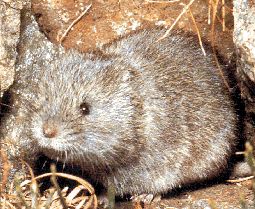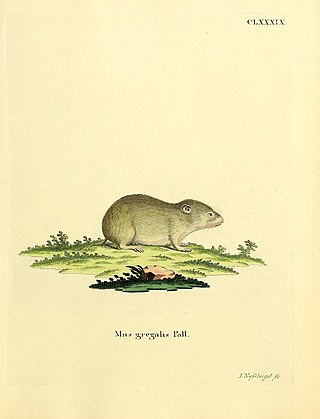
Voles are small rodents that are relatives of lemmings and hamsters, but with a stouter body; a longer, hairy tail; a slightly rounder head; smaller eyes and ears; and differently formed molars. They are sometimes known as meadow mice or field mice in North America.

The European water vole or northern water vole, is a semi-aquatic rodent. It is often informally called the water rat, though it only superficially resembles a true rat. Water voles have rounder noses than rats, deep brown fur, chubby faces and short fuzzy ears; unlike rats their tails, paws and ears are covered with hair.

The Arvicolinae are a subfamily of rodents that includes the voles, lemmings, and muskrats. They are most closely related to the other subfamilies in the Cricetidae. Some authorities place the subfamily Arvicolinae in the family Muridae along with all other members of the superfamily Muroidea. Some refer to the subfamily as the Microtinae or rank the taxon as a full family, the Arvicolidae.

Microtus is a genus of voles found in North America, Europe and northern Asia. The genus name refers to the small ears of these animals. They are stout rodents with short ears, legs and tails. They eat green vegetation such as grasses and sedges in summer, and grains, seeds, root and bark at other times. The genus is also called "meadow voles".

The North American water vole or just water vole is the largest North American vole. It is found in the northwestern United States and southern parts of western Canada. This animal has been historically considered a member of genus Arvicola, but molecular evidence demonstrates that it is more closely related to North American Microtus species. Water voles are on the USDA Forest Service Region 2 sensitive species list because they maintain very small populations and there is high concern that their required habitat may be declining.

The genus Arborimus is a group of voles found in western North America. The genus name is Latin for "tree mouse". Some sources include this genus with the heather voles, genus Phenacomys, and both are classified in the tribe Phenacomyini.

The water voles are large voles in the genus Arvicola. They are found in both aquatic and dry habitat through Europe and much of northern Asia. A water vole found in Western North America was historically considered a member of this genus, but has been shown to be more closely related to members of the genus Microtus. Head and body lengths are 12–22 cm, tail lengths are 6.5–12.5 cm, and their weights are 70–250 g. The animals may exhibit indeterminate growth. They are thick-furred and have hairy fringes on their feet that improve their swimming ability.

Alticola is a genus of rodent in the family Cricetidae.
Blanfordimys is a subgenus of voles in the family Microtus. It was formerly considered a distinct genus, but taxonomic studies group it within the Microtus radiation.

Chionomys is a genus of rodent in the family Cricetidae.

Ellobius is a genus of rodents in the family Cricetidae. It is the only member of the tribe Ellobiusini. It contains two of the handful of examples of mammal species that have lost the Y chromosome.

Eothenomys is a genus of rodent in the family Cricetidae. It contains the following species:
Hyperacrius is a genus of rodent in the family Cricetidae. It contains the following species:

Lasiopodomys is a genus of rodent in the family Cricetidae. It contains the following species:

The narrow-headed vole is a species of rodent in the family Cricetidae. It was previously placed in the genus Microtus, but modern listings either lump this into genus Lasiopodomys or split it out into Stenocranius. It ranges over northern and central Asia.
Smith's vole is a species of rodent in the family Cricetidae. It is also known as Smith's red-backed vole and is found only in Japan.
The Duke of Bedford's vole is a species of rodent in the family Cricetidae. After the Liangshan vole was removed from this genus, the Duke of Bedford's vole became the only member of the genus Proedromys. It is found only in mountainous parts of central China. It is a rare species and the International Union for Conservation of Nature has assessed its conservation status as being "vulnerable".
Volemys is a small genus of rodents in the family Cricetidae. It contains the following species, both of which are endemic to China:
The Clethrionomyini are a tribe of forest voles in the subfamily Arvicolinae. This tribe was formerly known as Myodini, but when genus Myodes was deemed to be a junior synonym, the tribe was renamed. Species in this tribe are:
Neodon is a genus of rodent in the family Cricetidae. Species within Neodon are classified as relics of the Pleistocene epoch because the occlusal patterns resemble the extinct Allophaiomys.












